Group H4 | Observed fall Yes | |
 | ||
The Sylacauga meteorite fell on November 30, 1954, at 13:46 local time (18:46 UT) in Oak Grove, Alabama, near Sylacauga. It is commonly called the Hodges meteorite because a fragment of it struck Ann Elizabeth Fowler Hodges (1920–1972).
Contents
Importance
The Sylacauga meteorite is the first documented extraterrestrial object to have injured a human being in the USA. The grapefruit-sized fragment crashed through the roof of a frame house, bounced off a large wooden console radio, and hit Hodges while she napped on a couch. The 34-year-old woman was badly bruised on one side of her body but able to walk. The event received worldwide publicity.
The Sylacauga meteorite was the first verified extraterrestrial object to hit a human being. A manuscript published at Tortona, Italy, in 1677 tells of a Milanese friar who was killed by a meteorite. In 1992 a small meteorite fragment (3 g) hit a young Ugandan boy in Mbale, but it had been slowed down by a tree and did not cause any injury.
Fireball
The meteor made a fireball visible from three states as it streaked through the atmosphere, even though it fell early in the afternoon. There were also indications of an air blast, as witnesses described hearing "explosions or loud booms".
Following events
The meteorite was confiscated by the Sylacauga police chief who then turned it over to the United States Air Force. Both the Hodgeses and their landlord, Bertie Guy, claimed the rock, Guy's claim being that it had fallen on her property. There were offers of up to $5,000 for the meteorite. The Hodgeses and Bertie Guy settled, with the Hodgeses paying $500 for the rock. However, by the time it was returned to the Hodgeses, over a year later, public attention had diminished, and they were unable to then find a buyer.
Ann Hodges was uncomfortable with the public attention and the stress of the dispute over ownership of the meteorite. The Hodgeses donated it to the Alabama Museum of Natural History in 1956.
The day after the fall, local farmer Julius McKinney came upon the second-largest fragment from the same meteorite. An Indianapolis-based lawyer purchased it for the Smithsonian Institution. The McKinney family was able to use the money to purchase a car and a house.
Fragments
Upon the entry into the atmosphere, the Sylacauga meteorite fragmented into at least 3 pieces:
- The Hodges fragment (3.86 kilograms (8.5 lb) - 33°11′18.1″N 86°17′40.2″W) struck Ann Elizabeth Hodges.
- The McKinney fragment (1.68 kilograms (3.7 lb) - 33°13′08.4″N 86°17′20.7″W) was found the next day December 1, 1954 by Julius Kempis McKinney, an African-American farmer who sold the meteorite fragment he found to purchase a car and a house.
- A third fragment is believed to have impacted somewhere near Childersburg (a few km north-west of Oak Grove).
Classification
The Sylacauga meteorite is classified as an ordinary chondrite of H4 group.
Orbit
The meteoroid came in on the sunward side of the Earth, so when it hit, it had passed the perihelion and was travelling outward from the Sun. Considering the orbit estimations, the best candidate as parent body is 1685 Toro.
